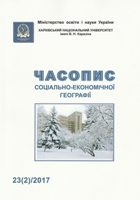Пострадянська трансформація сільського простору в Україні: від поляризації до децентралізації
Анотація
Розкрито причини на наслідки пострадянської трансформації сільських територій України, охарактеризовано просторові особливості виробництва аграрної продукції, доведено на конкретних прикладах поляризацію виробництва сільськогосподарської продукції. Розкрито особливості концентрації сільського населення навколо міст різної людності, визначено залежність між динамікою людності районних центрів і динамікою сільського населення навколо них, доведено зростання концентрації сільського населення у найближчих до міста сільських громадах, розкрито динаміку щільності сільського населення у розрізі сільських рад регіонів Українського Полісся. Охарактеризовано фінансові аспекти бюджетної децентралізації, визначено структуру власних доходів об’єднаних територіальних громад, здійснено оцінку ймовірного впливу децентралізації на розвиток сільських територій України.
Завантаження
Посилання
2. Baranovskyi, M.O. (2013). Suchasni tendentsii sotsialno-ekonomichnoi transformatsii silskykh terytoriy Ukrainy [Modern tendencies in socioeconomic transformation of the rural territories of Ukraine]. Visnyk Lvivskoho universytetu. Seriya Geografiya. Lviv, 46, 13-20.
3. Karacsonyi, D. (2011). Rural geography in Russia, Ukraine and in Belarus – a literature review. Hungarian Geo-graphical Bulletin, 60 (1), 79-99.
4. Karacsonyi, D. (2011). Rural geography of Ukraine. Budapest: Pazmany Peter setani, 210.
5. Karachoni, D. (2010). Sproba typologii silskoi mistsevosti v Ukraini [Attempt typology of rural areas in Ukraine]. Visnyk KNU imeni Tarasa Shevchenka. Geografiya, 57, 51-58.
6. Malchykova, D.S. (2009). Geoplanuvannya silskoi mistsevosti: osoblyvosti, problemy, obmezhennya [Geoplaning of the countryside: peculiarities, problems, limitations]. Naukovi zapysky VDPU imeni M. Kotsiubynskoho. Seriya: Geografiya, 19, 153-159.
7. Mezentsev, K., Pidhrushnyi, H., Mezentseva, N. (2014). Regionalnyi rozvytok v Ukraini: suspilno-prostorova nerivnist i poliaryzatsiya: monografiya [Regional development in Ukraine: socio-spatial inequality and polarization]. K.: DP “Print Servis”, 132.
8. Nefedova, T.H. (2003). Selskaia Rossiya na perepute: geograficheskie ocherki: monografiya [Rural Russia at the Crossroads: Geographical Sketches: monograph]. M.: Novoe izdatelstvo, 408.
9. Regionalnoe razvitie i regionalnaya politika Rossii v perekhodnyi period [Regional Development and Regional Policy of Russia in the Transition Period] (2011). M.: Izdatelstvo MGTU im. N. Baumana, 317.
10. Transformatsiya struktury hospodarstva Ukrainy: regionalnyi aspect [Transformation of the structure of the economy of Ukraine: the regional aspect] (2003). K.: Milenium, 404.
Авторське право (c) 2017 Микола Барановський

Цю роботу ліцензовано за Міжнародня ліцензія Creative Commons Attribution 4.0.




